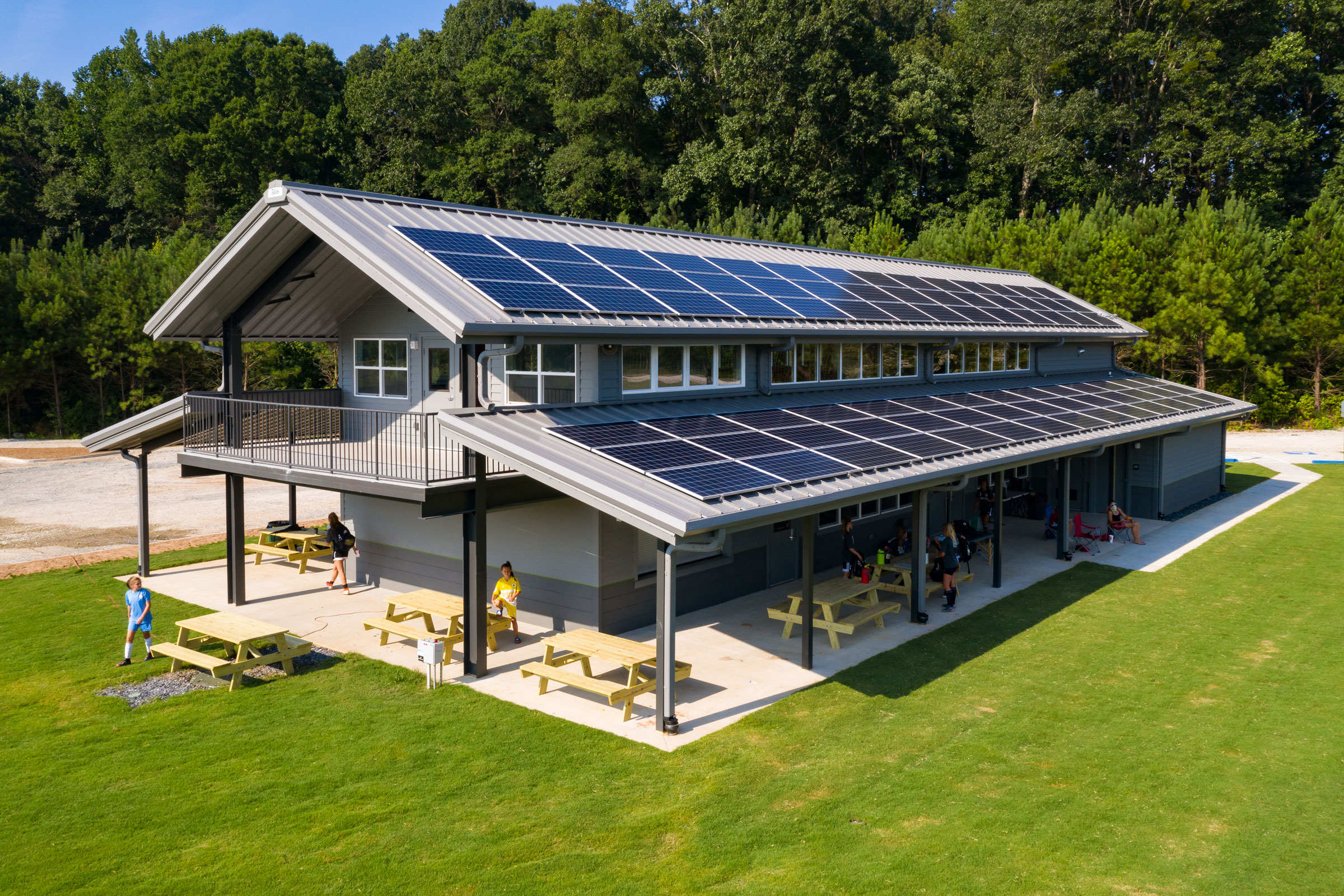Story at a glance:
- The 6,000-square foot pavilion provides the park with a classroom, restrooms, team rooms, shower facilities, a concession stand, office space, and large porch.
- Parking is limited to 3.5% of the project’s 98 acres, preserving the green space for wildlife and visitors alike.
- Plentiful PV panels, installed by Velo Solar, provide the power needed to operate the building year-round.
The team at Lord Aeck Sargent architecture firm designed the Georgia Sports Park Pavilion after Concorde Fire Soccer Club wanted to develop a sports complex. The soccer club wanted a place not only for youth soccer and other sports but also community engagement. In 2005 the leadership of Concorde Fire joined with the Georgia Sports Park leadership to create a venue for local, regional, and national sports. That park opened in 2007.
In 2017, with the success of the park and its recognition as one of the premier locations for soccer and ultimate, it was clear that the Georgia Sports Park was at a point in its development where a building would enhance the experience and meet the need for recreational space as well as an afterschool community program.
The Goal
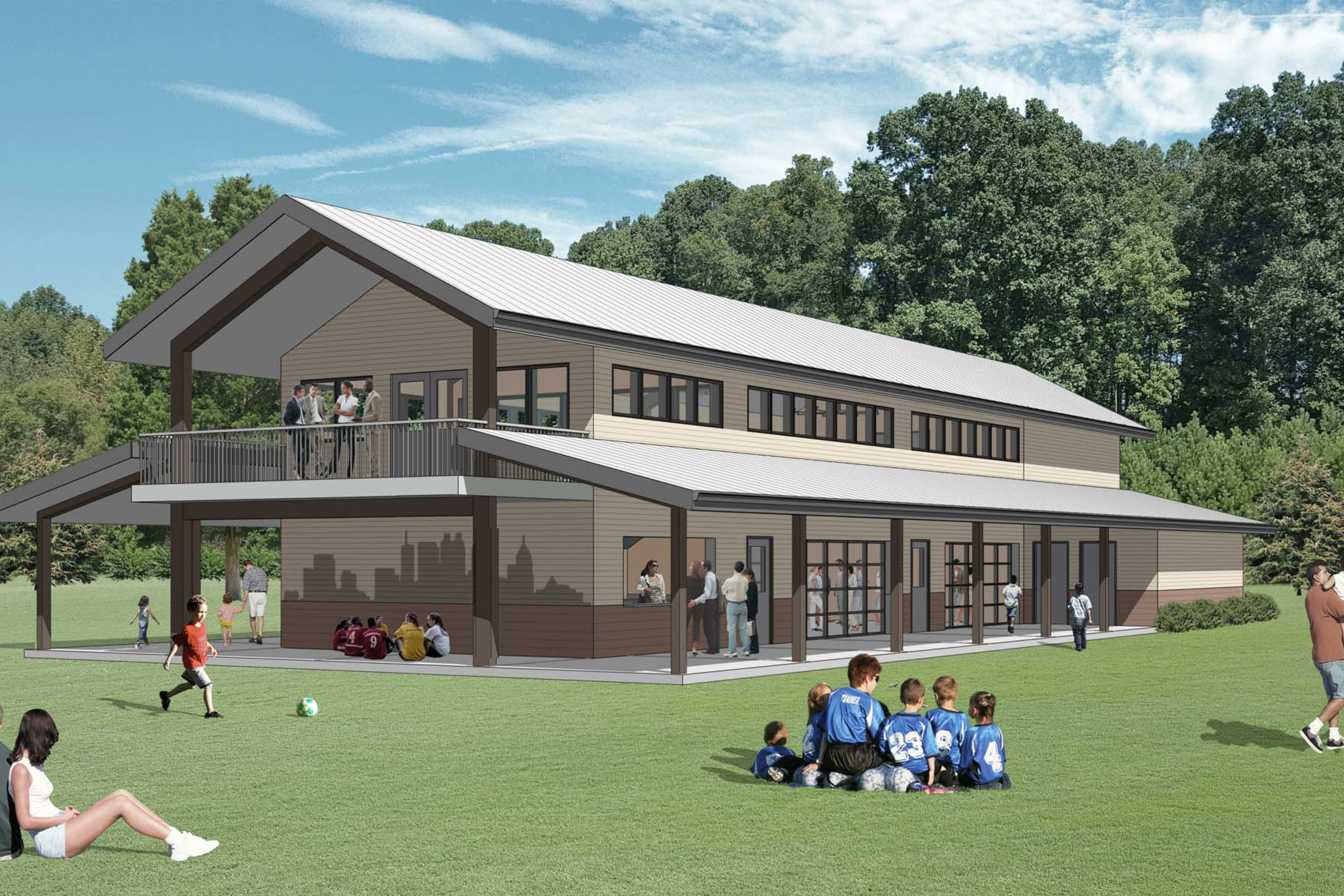
Rendering of new Georgia Sports Park Pavilion, opened in November 2020. courtesy of Lord Aeck Sargent
This project had to respond to the park’s needs while also being economically and environmentally sustainable. The approach was to find a balance between working within the available funding and doing so to achieve the functional goals in a sustainable way. And thus our design team set out to build the Georgia Sports Park Pavilion.
The 6,000-square foot sustainable pavilion designed by Lord Aeck Sargent provides the park with a classroom, restrooms, team rooms, shower facilities, a concession stand, office space, and large porch.
Together these serve as a gathering place but also to provide shelter and safety during hot sunny days and inclement weather alike. The multi-purpose building provides a safe, enjoyable visitor experience while making it possible for us to provide a wider range of services and programs.
The park with the pavilion will allow Georgia Sports Park to work toward enhancing the environment and social inequities, as we realize we cannot solve climate change without solving inequality at the same time.
These are the same problems from different perspectives. Thus, the underlying intentionality is to be a steward of the environment, embracing value in a regenerative future that’s in support of a just and equitable world.
The design approach to the project focused on several key guiding principles.
Design Approach
Guiding Principle #1: Place and Beauty
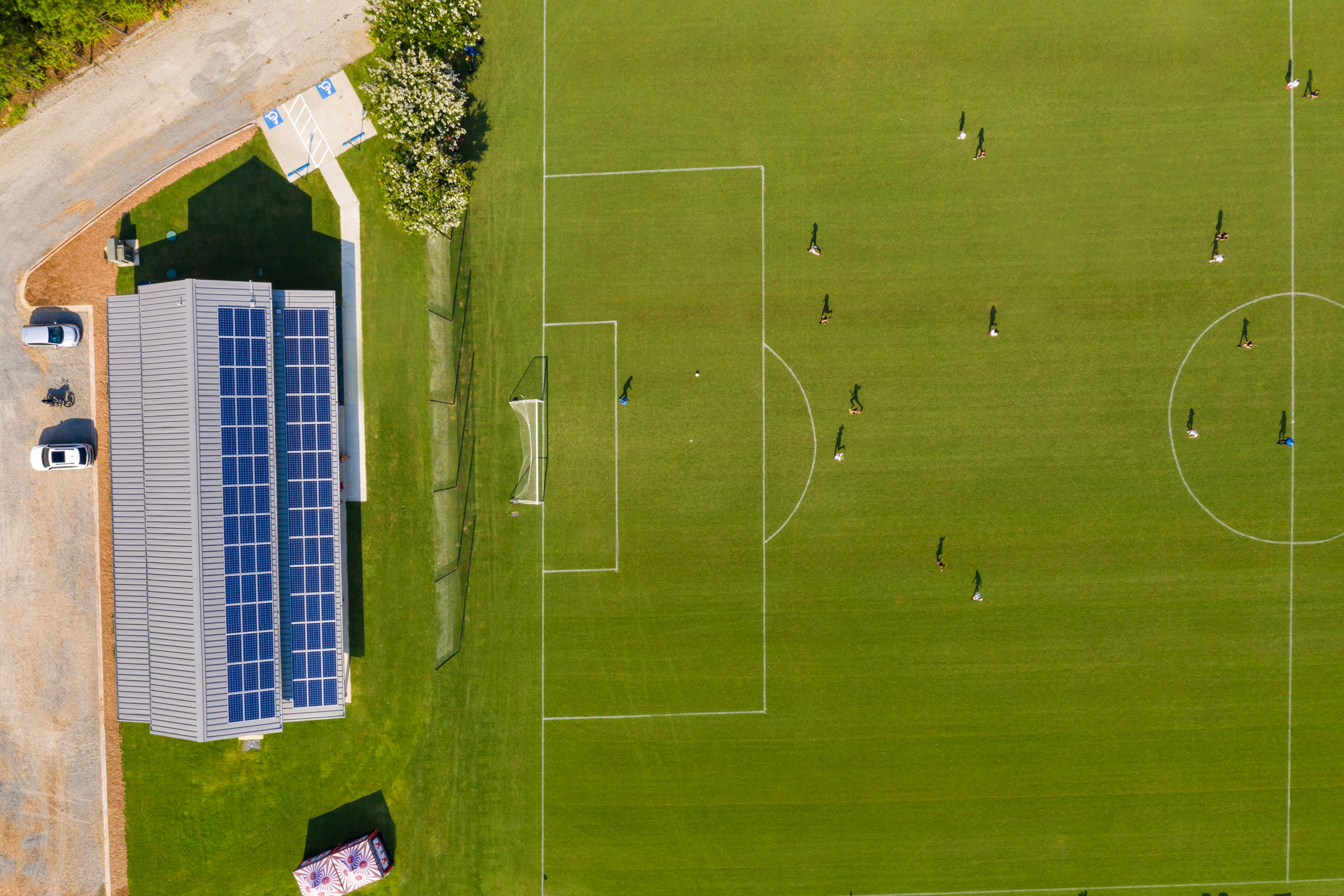
Georgia Sports Park Pavilion by Lord Aeck Sargent. Photo by Iran Watson Photo
Georgia Sports Park is in East Point, Georgia, part of metropolitan Atlanta, one of the US’s greenest cities. It’s a special place that contributes positively to the enhancement of the environmental, community, social, cultural, historical, and economic surroundings.
Place is an important aspect to any project. This 98-acre site is grounded in a healthy relationship with nature and is well suited for sports fields, as it’s nestled in a flood plain, an appropriate location for sports fields, and surrounded by a beautiful forest with a creek running adjacent.
The pavilion was conceived as a place with health and wellness as important aspects. On a day without sports, it’s exhilarating to see turkeys, geese, and deer make their way across the fields.
The pavilion also adds a safe and enjoyable visitor amenity to the park. Parking is limited to only 3.5% of the 98 acres, far less than a normal urban ratio—keeping more green space for the earth and visitors.
We have six grass athletic fields with trees between the fields. Most of the parking lots are pervious gravel, allowing water to percolate into the soil to filter out pollutants and recharge the groundwater.
Landscaping utilizes native plant materials. The man-made irrigation pond is designed to capture, store, and distribute necessary watering for the sports fields and does not use potable water.
A vegetative drainage bioswale is designed to concentrate and convey stormwater runoff from the parking lot while removing debris and pollution as well as recharging groundwater.
Guiding Principle #2: The Sun
The most influential natural element in building design is the effect of the sun. The pavilion responds with its shape, orientation, envelope, location of internal spaces, and shading.
The sun has a direct relationship on the amount of energy used because of solar radiation (heat gain) on exposed surfaces. Because every facade is affected differently by the sun, each elevation should be considered individually, but still as part of the whole.
Studies show that an elongated rectangle with the short sides facing east and west is the most responsive to the sun because it minimizes the amount of surface and heat buildup on the east and west walls when the direct sun is lower in the sky. To respect the sun, the pavilion follows that principle and is oriented east to west so the east and west elevations have the least amount of exposed surface and thus the least heat buildup.
To respond to the heat gain from the south and west, deep overhangs with porches on the lower level shade the glass in the summer months but allow the sun to enter the upper glass in the winter to assist with heating. To respond to the east elevation the placement of toilet rooms and team changing rooms requires only transient conditioning, not the same as for extended occupancy conditioning required for the occupancy of the classroom.
To limit the sun’s effect on the interior space, the exterior walls are very well insulated, more than the code requirements, and the windows are low-E, double pane to buffer from the outside ambient temperature in the summer and the winter.
The sun on the east, south, and west walls was analyzed for what impact it has on the interior space. In the summer the sun can add to the cooling load so shading as much of that wall and all the windows is critical. The south elevation of the pavilion has a porch that completely shades the lower level south wall year-round. The glazing of the upper level glass is shaded by the roof overhang, keeping direct sun off of the glass in the summer while allowing sun to enter through the windows in the winter with a positive effect.
Guiding Principle #3: Energy from the Sun
Power is provided by the sun through 70 flat 340-watt photovoltaic solar panels on the south sloping roof. The array provides more than enough energy to power the building during daylight hours.
The PV panels, installed by Velo Solar, provide the power needed to operate the building year-round.
The energy from the sun provides more than twice that needed to run the building, resulting in the building’s energy performance being net-positive. The excess energy is returned to the East Point Power grid. Further, peak demand for energy comes at the same time the PV system is producing its best response to energy needs. The good news is, in looking to the future, the solar power systems do not require a lot of maintenance, usually only requiring cleaning a couple of times a year.
Guiding Principle #4: Human Comfort
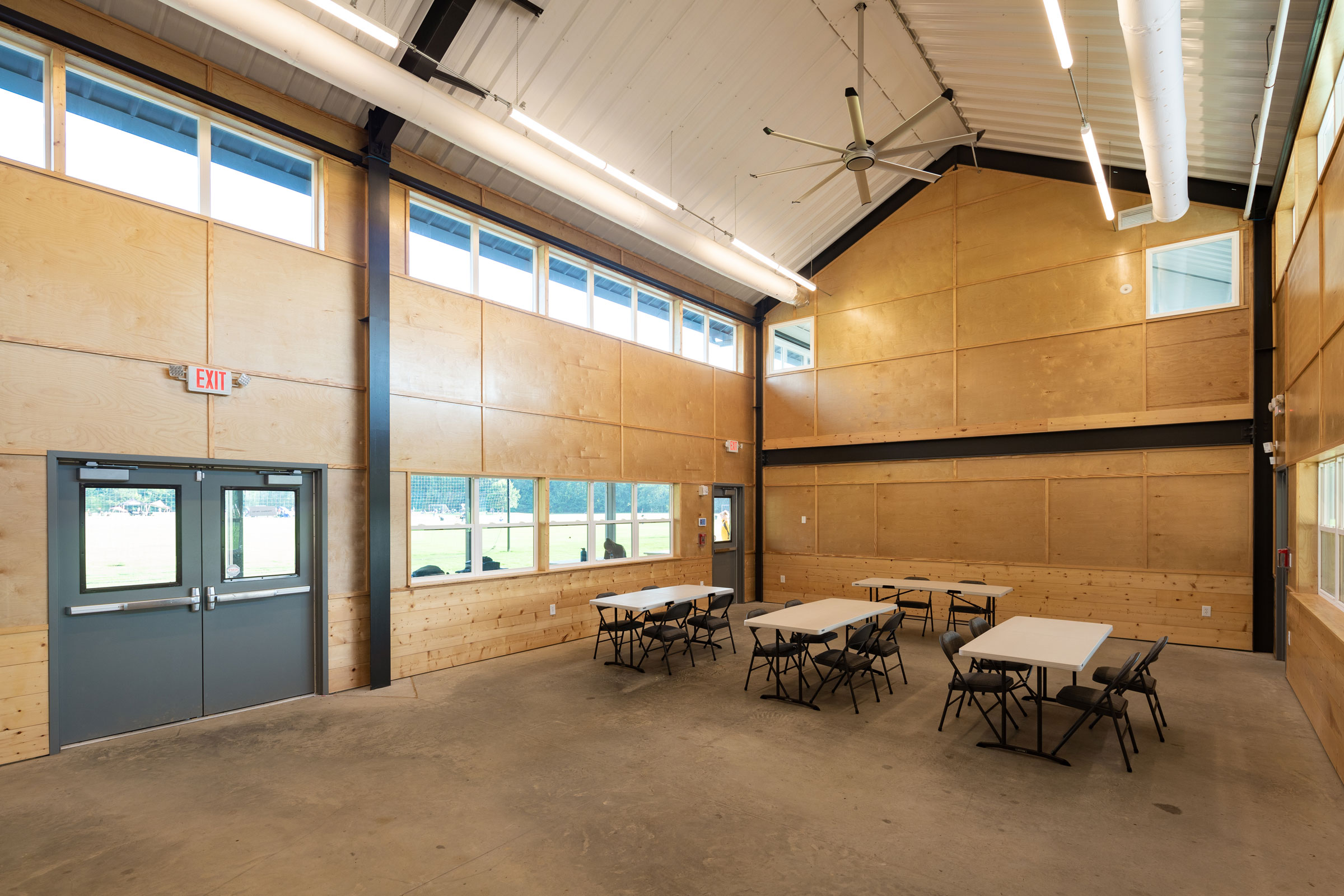
Inside the Georgia Sports Park Pavilion, complete with a Big Ass Fan. Photo by Iran Watson Photo
The building was designed with spaces that optimize health and wellness.
Indoor air quality and comfort responds to climate beginning with what people wear as appropriate for the season and location. Attitudes about what one thinks about comfort is a behavioral and a learned social adjustment that, over time, will influence the way people “feel” about comfort in indoor spaces.
When people come into a space, the difference in temperature is psychologically processed, i.e. if you have been outside in the summer, you are probably wearing light clothing and, as a result, a relatively cold space would actually be uncomfortable. In lieu of low temperature air conditioning that cools the space rather than the people, in this case, the space temperature in the summer is set at 78°F, with relative humidity above 50% and large ceiling fans from Big Ass Fans that produce a gentle breeze and result in evaporative cooling. The result changes the amount of time the air conditioning is running and provides much-reduced energy consumption.
The classroom is a two-story space with operable windows reminiscent of vernacular southern architecture, or structures that were constructed with natural ventilation in mind by opening the windows.
A different principle exists for winter. Operating with heat rising, the fans slowly turn and thoroughly mix the air without creating a draft but bringing the warm air back down to the floor. Air velocity at the floor does not exceed the limit for drafts set in ASHRAE Standard 55, the method for determining acceptable thermal conditions in occupant-controlled naturally conditioned spaces.
Using Geothermal
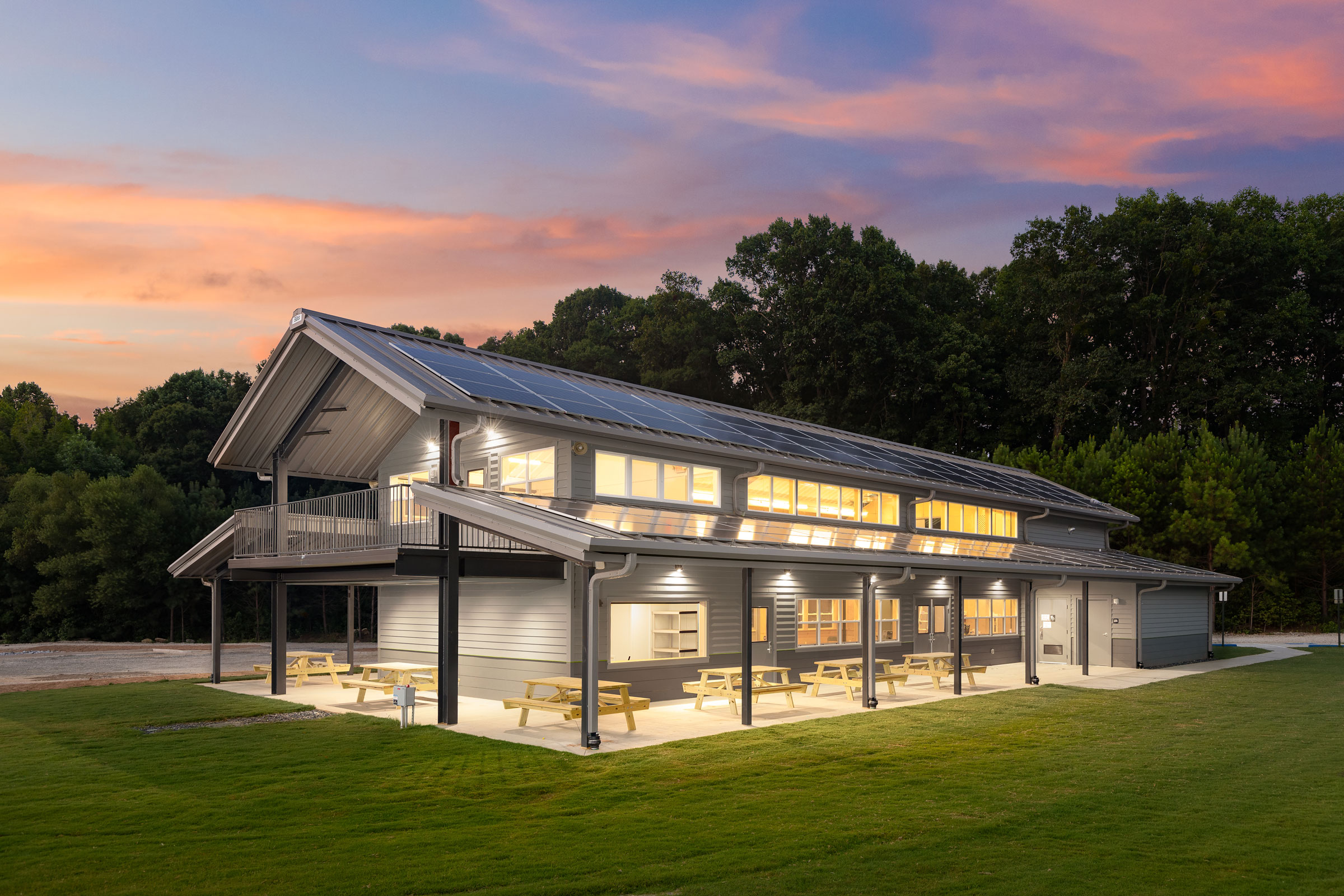
Georgia Sports Park Pavilion by Lord Aeck Sargent. Photo by Iran Watson Photo
Once we reduced the loads in the building with good orientation, operable and shaded windows, a porch, and a well-insulated envelope, we chose a geothermal HVAC system because it is environmentally friendly, sustainable, and reliable.
Geothermal systems encourage conservation of natural resources by using the steady temperature of the ground to heat and cool. According to the EPA geo-exchange systems can save 30 to 70% in heating costs and 20 to 50% in cooling costs, compared to conventional systems.
The geothermal HVAC system, designed by Johnson Spelman Engineers and installed by EcoMech Geothermal, is a system (WaterFurnace™) where horizontal high density polyethylene piping was buried seven feet in the ground to absorb the ground temperature then run through a geothermal heat pump to provide comfortable and cost-effective heating and cooling.
While air temperatures can vary greatly from day to night or winter to summer, the temperature just a few feet below the earth’s surface stays between 55° to 70°F year-round. This provides access to an energy source for heating, air conditioning, and hot water.
This system is in lieu of an ordinary heat pump or furnace that collects heat from frigid winter air or by burning gas. And, unlike a furnace, geothermal units do not create heat through combustion. In the summer the ground loop water system collects the unwanted heat and moves it to the cooler earth. Ordinary heat pumps and air conditioners dump that heat outside, but, unfortunately, hot summer air is already saturated with heat and is less willing to accept more. That makes ordinary cooling systems least efficient when you need them to be the most.
A geothermal heat pump heating and cooling system was chosen since it’s the most highly efficient and cost-effective system available. All the equipment is 41 EER (about 55 SEER but not relevant since the ground loop does not recognize seasons). It uses the free renewable solar energy stored in the ground rather than burning fossil fuels. But what is most impressive is the level of comfort it provides. The system operates for longer periods at lower speeds, making the pavilion consistently comfortable all year.
What About Radiant Heat?
For energy efficiency and comfort in the winter, the ground floor slabs have radiant heating. Because of its energy efficiency and clean draft-free heat, concrete radiant floor heating provides numerous environmental benefits. In the pavilion less energy is required to achieve desired thermal comfort at a lower thermostat setting. A small 1/6 horsepower pump circulates the water at the desired temperature, which we set at 66°F throughout the winter. The slab then radiates this heat to people in the space, allowing the space to be comfortable without needing to heat the entire volume of the two-story main space.
The HVAC system provides total comfort and superior indoor air quality at the lowest energy use and resulting cost to the environment.
Indoor Air Quality
The EPA named indoor air quality as one of the top five health threats in the US. That is because people spend a lot of time indoors. As buildings become more energy-efficient, they are less likely to circulate fresh, clean air, and more likely to accumulate unsafe levels of particles, bacteria, mold spores, and volatile organic compounds (VOCs).
In addition to increasing the amount of outside air, we installed Bipolar Ionizer purification technology (Atmos Air™) to contribute to better health by providing cleaner indoor air by eliminating as much pollution or contaminants as possible while reducing energy use and emissions in the process.
To further improve filtration on the outside air as well as the return air for recirculation, MERV 13 Pleated AC Furnace Air Filter, the highest efficiency commercial filtration, is installed and sealed to prevent bypass to properly filter the air.
All-natural solutions have been field- and lab-tested against many contaminants of concern. The system reduces mold and the spread of airborne particles, including some viruses and bacteria that pass through normal filtration systems. The system greatly reduces VOCs, bacteria, dust particles, mold spores, and odors in classroom, toilet, and the team room spaces.
The continuous application of Bi-Polar Ions is emitted to ambient air by continuously disinfecting both the breathing space and surfaces. It is the most effective system for continuously cleaning and decontaminating indoor air.
Currently the possibility of aerosolized spread of COVID-19 and the ability of particles to hang in the air for extended periods of time makes the inclusion of an active air cleaning strategy even more prudent. The objective is to keep the PMR 2.5 below 12 parts per million, which the system as designed accomplishes. The ionizer combined with the overhead fans and the opportunity to open the windows, bring air quality close to outdoor air quality resulting in improved human wellness.
Using Light
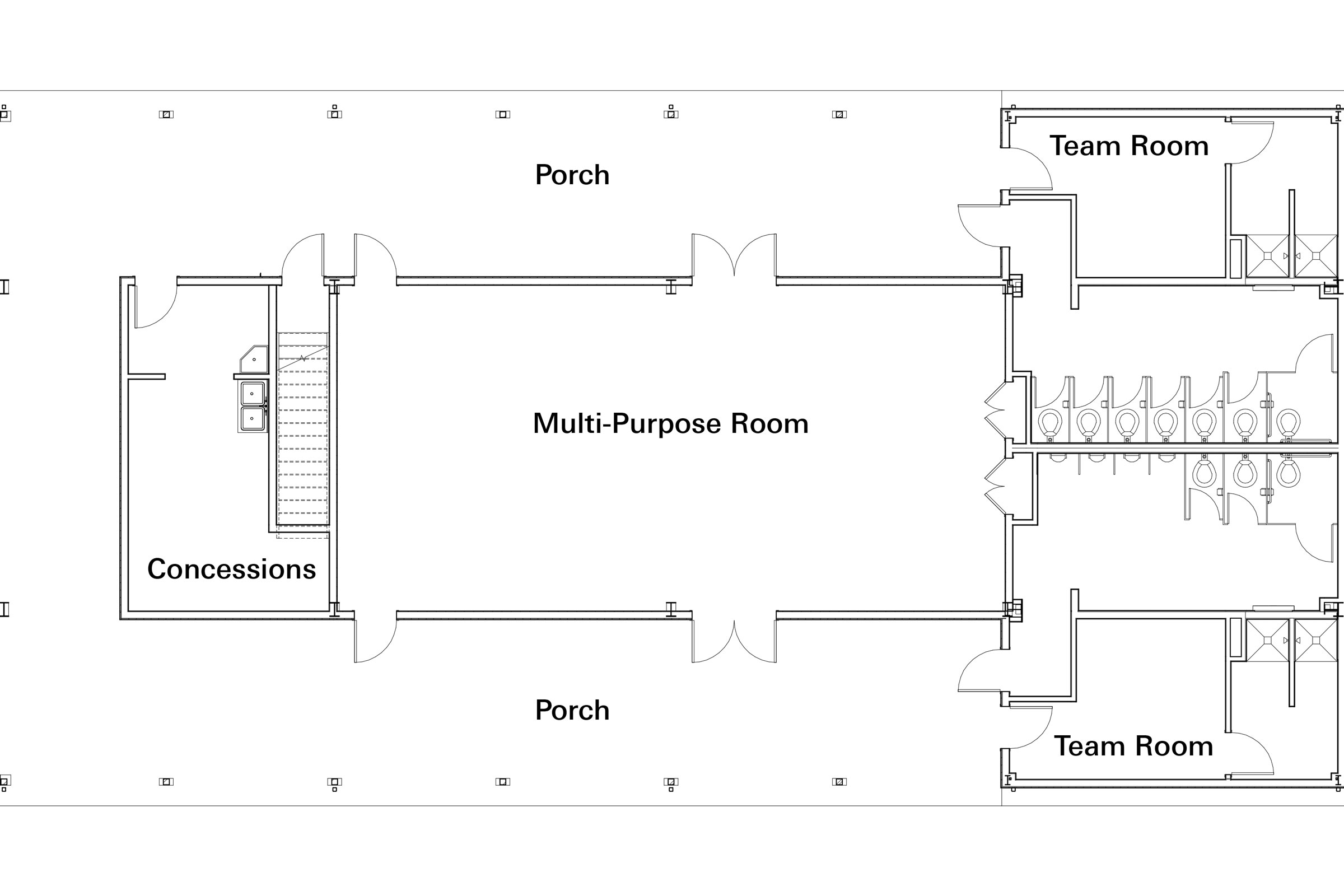
Floor plan for the Georgia Sports Park Pavilion. Courtesy of Lord Aeck Sargent
The artificial light sources for the pavilion are light-emitting diode (LED), which is a semiconductor light source that emits light when current flows through it. LED lighting has become the default source for electric lighting in almost every sustainable application.
An LED light source is valued as much for the ability to create comfortable, pleasing light conditions as for its energy efficiency.
LEDs provide a wider spectrum of light, promoting comfort, which increases the occupant’s ability to see objects in true color.
One reason daylight is such a pleasant light source is that it provides the full spectrum of light. LED technology has now advanced to the point where high-quality LEDs are able to provide the full spectrum of light, or close to it as has been installed in the pavilion.
Designed by Barnett Consulting Engineers and Ardd + Winter, the light level in the classroom was designed using less than 700 watts of artificial light. To optimize the efficacy of the lighting in the space, and after specifying high-performance light sources, lighting controls are used to further reduce energy use.
During the clear daylight hours with all the lights on, the incident light can be as bright as 80 foot candles, however, when the foot candles increase beyond 40 foot candles, the light level photo sensors reduce the light level to keep the classroom between 40 and 50 foot candles. The remainder of the spaces also have the appropriate amount of LED light. The pavilion also uses occupancy sensors which turn lights on or off in response to the presence of occupants.
Managing Water

Floor plan for the Georgia Sports Park Pavilion. Courtesy of Lord Aeck Sargent
What was once thought of as abundant fresh water now points to significant problems ahead due to the impacts of climate change, highly unsustainable water use patterns, and the continued drawdown of major aquifers.
Although desired, the pavilion could not be designed with a stand-alone water treatment system to achieve water independence due to cost. However, the pavilion uses rainwater harvested from the roof through roof gutters and exterior downspouts then through an underground piping system to an 1,800-gallon underground storage tank.
The collected water system designed and installed by Georgia Water Tanks is treated including UV-C light and run through a pressure system to provide sufficient quantity to operate the water closets. UVGI devices can produce strong enough UV-C light in circulating water systems to make them inhospitable environments to microorganisms such as bacteria, viruses, molds, and other pathogens.
Toilet fixtures carry the EPA WaterSense label, and waterless urinals are another water- saving response in the pavilion. In the team rooms we do have showers, which can be a leading water demand. The water closets are high-efficiency toilets, which use no more than 1.28 gallons of water per flush, so they make a substantial reduction in the overall water demand. The urinals are waterless, not requiring water to flush.
In the team rooms the showers have low-flow showerheads that operate with push button activators. The showerheads have a flow rate of less than 1.5 gallons per minute with a pressure of 80 psi. In order for people to not use excessive water, showers have a push button actuator set for 1 minute for each push. It takes about one minute for the shower water to get hot for the first shower then a shower can be taken in 3 or 4 pushes, less than 6 gallons of water. Also, the handwashing sinks operate with push button activators set for 20 seconds—the recommended time for effective handwashing.
It’s important to note that we recognize athletic fields require water to keep the grass playable. At Georgia Sports Park we use exterior irrigation supplied by well and rain from an on-site pond for water retention to provide field and landscape irrigation.
With the rainwater harvesting providing all the water for toilet flushing, low flow toilet fixtures, waterless urinals, push button low flow faucets, and push button operated low flow shower heads, we calculate the total potable water savings exceeds 85%.
Choosing Sustainable Building Materials
Sustainable building materials were selected for durability and low maintenance to reduce both cost and environmental impact of long-term building operation—including concrete floors, fiber cement siding, and plywood interior wall panels.
A steel structure (or pre-engineered metal building) designed by SBS was chosen for the pavilion because of its lower cost and timely production and delivery.
The benefits of steel structures are many, as they provide necessary strength, are resistant to pests, and are non-combustible. Steel is one of the most widely used building materials in construction today. Steel can be fabricated in a wide variety of shapes to achieve the proper strength for all applications. A sustainable advantage of steel is its recyclability. In the pavilion the steel structural elements are documented to be made from 71.6% recycled content and can be again recycled at the end of its current use in the pavilion.
The concrete slabs and foundations with the integrated tubing for the radiant floor were designed by Sykes Consulting.
Fiber-cement siding is used for the exterior enclosure. This siding is made from recycled material and other sustainable products. Fiber-cement siding is a green building material that lasts for more than 50 years. If removal is ever contemplated, this siding can also be recycled. Fiber-cement siding products have published Health Product Declaration 100% of intentionally added ingredients are not listed as part of Living Building Challenge 3.1 Red Lilt.
The interior walls are pine wooden studs and birch plywood paneling, which was used because wood is a natural product made from a renewable resource with little impact on the global environment. Even though the plywood is made up of several layers of thin wood glued together, the plywood chosen for this project uses glues with low VOC and formaldehyde emissions.
Design for Equity
As our community continues to evolve and change, fostering environmental sustainability through building design initiatives incorporated into Georgia Sports Park, the objective was to inspire other organizations to adopt similar strategies.
The project objective of community participation, incorporating several nonprofit organizations, philanthropic foundations, corporate neighbors, and the City of East Point to contribute to the public good in an amount commensurate with the project use and expense, was accomplished and will be improved with the intended uses. The enthusiastic support and input from the City of East Point and the Andrew & Walter Young Family YMCA allows us to have sports activities and afterschool programs for the benefit of the youth of our community.
A more just and equitable world is an important outcome of the programs and mission that will be carried out here. The project will encourage evidence-supported opportunities to sustain the environment and enhance health and wellness through challenging people’s thinking about the design of buildings and organizational mission. Organization owners, property managers, designers, investors, and others involved in project decision making, after visiting or reading about the success at Georgia Sports Park, will use the strategies learned to create places that contribute to healthier people and communities and will serve to enhance and preserve value by meeting the growing desire for contributing to a sustainable world.

